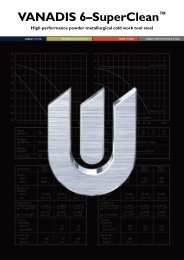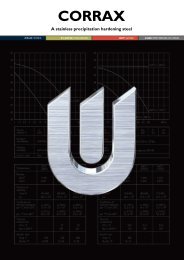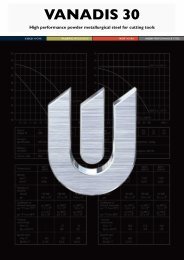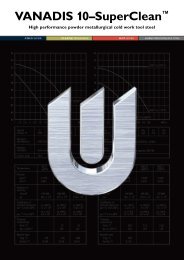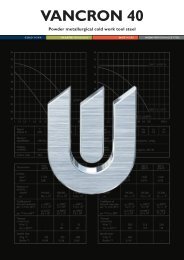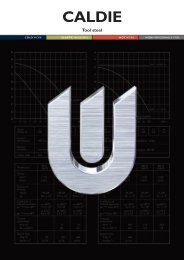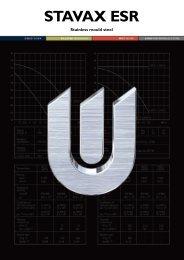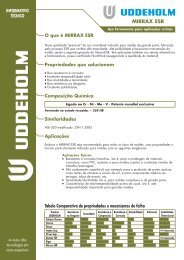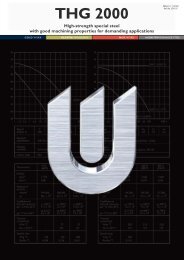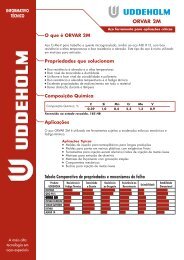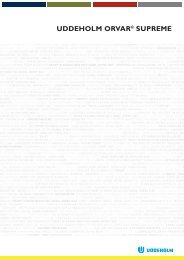Prehardened cold work tool steel for car body dies - Uddeholm
Prehardened cold work tool steel for car body dies - Uddeholm
Prehardened cold work tool steel for car body dies - Uddeholm
Create successful ePaper yourself
Turn your PDF publications into a flip-book with our unique Google optimized e-Paper software.
6<br />
CARMO<br />
Flame-hardening<br />
Use an oxy-acetylene burner <strong>for</strong> 1250–2500 l/h<br />
with a normal flame.<br />
Temperature: 950 ±30°C (1740 ±50°F).<br />
Hardness: surface 58 ±2 HRC, at a depth of 3–4 mm<br />
400 HV 10 kg .<br />
A temperature guide <strong>for</strong> judgement of the right<br />
flame hardening temperature can be obtained from<br />
your local <strong>Uddeholm</strong> office.<br />
Welding<br />
recommendations<br />
GENERAL<br />
When <strong>cold</strong> <strong>work</strong> <strong>steel</strong>s are welded, there is always<br />
a risk of cracking in the weld metal and/or in the<br />
heat affected zone (HAZ). However, cracking can<br />
be avoided by using a proper welding technique<br />
and the right consumables. Wrought material is<br />
always easier to weld than castings because it has a<br />
higher toughness.<br />
In general, the following is valid:<br />
• Always keep the arc length as short as possible.<br />
The coated electrode should be angled at 90° to<br />
the joint sides to avoid undercut. In addition, the<br />
electrode should be held at an angle of 75–80°<br />
to the direction of <strong>for</strong>ward travel.<br />
• Larger repair welds must be made at elevated<br />
temperature. The temperature of the <strong>work</strong>piece<br />
should be held as constant as possible during<br />
welding. The best way to keep the <strong>tool</strong> at constant<br />
temperature during welding is to use an<br />
insulated box with thermostatically regulated<br />
electrical heating elements inside the walls.<br />
• The first two layers should always be welded<br />
with the same heat input and with a small diameter<br />
electrode (max 3,25 Ø electrode <strong>for</strong><br />
MMA or max 120A <strong>for</strong> TIG welding).<br />
• First of all, the parent metal is clad in using an<br />
appropriate number of runs. All other runs<br />
should then be made up on top of pre-existing<br />
weld metal except in those cases where soft<br />
metal electrodes of the type 29/9 are used.<br />
When a soft weld metal is used, a space of<br />
3 mm must be left below the finished surface so<br />
that the hard facing electrode can be used to<br />
give the right surface hardness on the welded<br />
<strong>tool</strong>.<br />
• For large weld repairs, the parent metal should<br />
be coated with a soft weld metal of the 29/9 type<br />
(i.e. 29% Cr, 9% Ni electrodes AWS ER 312 or<br />
AWS E312), which gives a tougher weld metal<br />
with lower hardness.<br />
• The choice of electrode <strong>for</strong> welding depends on<br />
the hardness required in the weld metal (see<br />
table below).<br />
• In order to obtain the required hardness (as<br />
given in the table below), the weld should be<br />
built up with at least 3 layers plus an additional<br />
layer which is ground off after welding has been<br />
completed. When welding <strong>tool</strong> <strong>steel</strong>s, the last<br />
layer should always be ground off.<br />
• It should be noted that differences between expected<br />
and achieved hardness in the weld metal<br />
normally depend on how the grinding of the last<br />
layer has been <strong>car</strong>ried out. Grinding should<br />
always be <strong>car</strong>ried out be<strong>for</strong>e the temperature in<br />
the <strong>tool</strong> sinks too much. If the grinding is too<br />
rough so that the weld becomes red hot, microcracks<br />
will appear in the weld metal.<br />
• The following heat treatment cycle is recommended<br />
<strong>for</strong> large weld repairs:<br />
1. Pre-heat the <strong>tool</strong> to 200–250°C (390–480°F).<br />
Keep that temperature during the whole<br />
welding operation.<br />
2. Let the <strong>tool</strong> cool slowly after welding to 70°C<br />
(160°F).<br />
3. Temper the <strong>tool</strong> at a temperature 20°C<br />
(70°F) below previously used preheating<br />
temperature.<br />
JOINT PREPARATION<br />
The importance of <strong>car</strong>eful joint preparation cannot<br />
be over-emphasized. Cracks should be ground out<br />
so that the joint bottom is rounded and the sides of<br />
the joint slope at an angle of at least 30° to the<br />
vertical. The width of the joint bottom should be at<br />
least 1 mm greater than the electrode diameter<br />
(including the coating) which is used.<br />
Further recommendations on welding of <strong>tool</strong> <strong>steel</strong>s<br />
can be found in the <strong>Uddeholm</strong> brochure “Welding<br />
of Tool Steel”.<br />
TIG Welding Consumables <strong>for</strong> wrought CARMO<br />
Hardness<br />
Condition Hardness after re- Preheating 1)<br />
of material Consumables as welded hardening temperature<br />
Hardened Avesta P7 2) 240 HB Austenitic<br />
Pre- CastoTig 680 2) 230 HB Austenitic<br />
hardened UTPA 73G2 53–56 HRC 57 HRC<br />
UTPA 67S 55–58 HRC 52 HRC<br />
CastoTig 5 3) 60–64 HRC<br />
CARMO/<br />
CALMAX<br />
TIG WELD 4) 58–61 HRC 58–61 HRC<br />
200–250°C<br />
(390–480°F)



